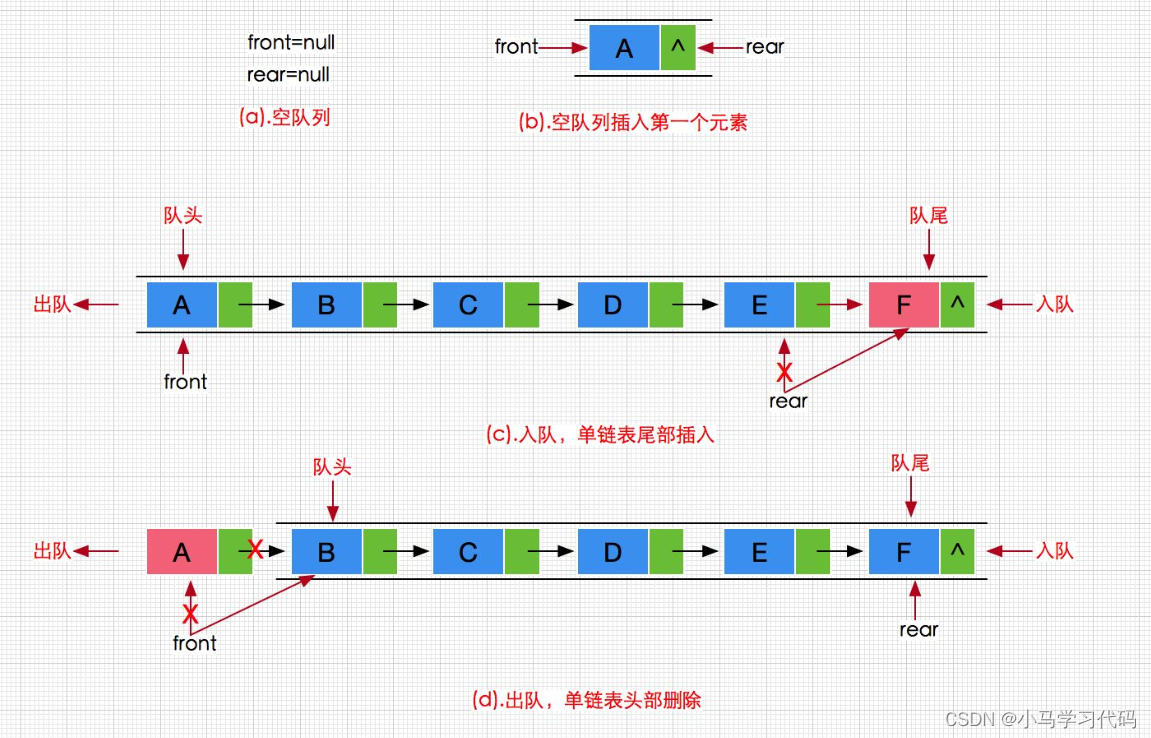前言:
关于c语言的学习已经差不多更新完毕,如果发现个别知识点,我还会继续更新,但目前已经准备往c++和数据结构的重心挪动,这篇文章就是向大家讲述数据结构中栈和队列的实现。
💞 💞 欢迎来到小马学习代码博客!!!!
你来人间一趟,你要看看太阳!!!!
目录
一、数据结构体栈
1.1栈的概念及结构:
栈:一种特殊的线性表,其只允许在固定的一端进行插入和删除元素操作。进行数据插入和删除操作的一端称为栈顶,另一端称为栈底。栈中的数据元素遵守后进先出LIFO(Last In First Out)的原则。

~~~~记住一个原则,先进的后出,后进的先出。~~~~
1.2栈的实现:
栈的实现一般可以使用数组或者链表实现,相对而言数组的结构实现更优一些。因为数组在尾上插入数据的代价比较小。我们保证首先插入的后面出来就行。
1.2.1栈的定义:
typedef int STDataType; //重定义int
typedef struct Stack{
STDataType* a;
STDataType top; //栈顶
STDataType capicity;
}ST;1.2.2栈的初始化:
void StackInit(ST*ps)
{
assert(ps);
ps->a=NULL; //先指向空指针
ps->top=ps->capicity=0; 初始化都为零
}1.2.3栈的销毁:
void StackDestroy(ST*ps)
{
assert(ps); //断言一下防止空指针
free(ps); //进行释放因为我申请的是动态内存
ps=NULL;
ps->top=0;
ps->capicity=0;
}1.2.4判断栈是否为空:
bool StackEmpty(ST*ps)
{
assert(ps);
return ps->top==0; //如果top等于0则证明栈为空,返回true
}1.2.5栈的压栈(push):
void StackPush(ST*ps,STDataType x)
{
assert(ps); //断言一下
if(ps->top==ps->capicity) //如果top(栈顶)=capacity则证明容量已经满了需要扩容一下
{
int newcapicity=ps->capicity==0?4:(ps->capicity)*2; //和顺序表扩容一样
STDataType* ptr = (STDataType*)realloc(ps->a, newcapicity*sizeof(STDataType)); //进行动态扩容
if(ptr==NULL) //防止扩容失败
{
perror("StackPush");
exit(-1);
}
ps->a=ptr; //把扩容成功的地址传给a
ps->capicity=newcapicity; //把扩容后的新newcapicity给capacity
}
ps->a[ps->top]=x; // 插入元素x
++ps->top; //top进行++
}
1.2.6栈的出栈(Pop):
void StackPop(ST*ps)
{
assert(ps);
assert(!StackEmpty(ps)); //这里判断是否为空栈如果为空栈就不能在进行出栈了
--ps->top; //只需要让top减一个就行了
}1.2.7栈顶的元素查看:
STDataType StackTop(ST* ps)
{
assert(ps);
assert(!StackEmpty(ps));
return ps->a[ps->top - 1]; //因为进行push后top++了一下,所以栈顶需要top-1
}1.2.7栈的元素个数:
int StackSize(ST* ps)
{
assert(ps);
return ps->top;
}
栈还是比较容易实现的,如果熟练掌握顺序表我相信大家还是很容易就能把栈写出来。
1.3栈实现的全部代码:
1.3.1 .c
#include "Stack.hpp"
void StackInit(ST*ps)
{
assert(ps);
ps->a=NULL;
ps->top=ps->capicity=0;
}
void StackDestroy(ST*ps)
{
assert(ps);
free(ps);
ps=NULL;
ps->top=0;
ps->capicity=0;
}
void StackPush(ST*ps,STDataType x)
{
assert(ps);
if(ps->top==ps->capicity)
{
int newcapicity=ps->capicity==0?4:(ps->capicity)*2;
STDataType* ptr = (STDataType*)realloc(ps->a, newcapicity*sizeof(STDataType));
if(ptr==NULL)
{
perror("StackPush");
exit(-1);
}
ps->a=ptr;
ps->capicity=newcapicity;
}
ps->a[ps->top]=x;
++ps->top;
}
bool StackEmpty(ST*ps)
{
assert(ps);
return ps->top==0;
}
void StackPop(ST*ps)
{
assert(ps);
assert(!StackEmpty(ps));
--ps->top;
}
STDataType StackTop(ST* ps)
{
assert(ps);
assert(!StackEmpty(ps));
return ps->a[ps->top - 1];
}
int StackSize(ST* ps)
{
assert(ps);
return ps->top;
}
1.3.2 .h
#ifndef Stack_hpp
#define Stack_hpp
#include <stdio.h>
#include<assert.h>
#include<stdbool.h>
#include<stdlib.h>
typedef int STDataType;
typedef struct Stack{
STDataType* a;
STDataType top;
STDataType capicity;
}ST;
void StackInit(ST*ps);
void StackDestroy(ST*ps);
void StackPush(ST*ps,STDataType x);
void StackPop(ST*ps);
bool StackEmpty(ST*ps);
STDataType StackTop(ST* ps);
int StackSize(ST* ps);
#endif /* Stack_hpp */
1.3.3 test
测试我这里是随便测试了一下,大家可以自己进行不同的测试就行不必和我一样
#include "Stack.hpp"
void TestStack()
{
ST st;
StackInit(&st);
StackPush(&st, 1);
StackPush(&st, 2);
StackPush(&st, 3);
printf("%d ", StackTop(&st));
printf("%d ",StackSize(&st));
StackPop(&st);
//printf("%d ", StackTop(&st));
StackPop(&st);
StackPush(&st, 4);
StackPush(&st, 5);
while (!StackEmpty(&st))
{
printf("%d ", StackTop(&st));
StackPop(&st);
}
printf("\n");
}
int main()
{
TestStack();
return 0;
}
二、数据结构队列:
2.1数列的概念和结构:
队列:只允许在一端进行插入数据操作,在另一端进行删除数据操作的特殊线性表,队列具有先进先出 FIFO(First In First Out) 入队列:进行插入操作的一端称为队尾 出队列:进行删除操作的一端称为队头。 队列和栈的区别就是先进的后出,就和排队买东西一样,先排队的先买,说白了就是先到先得。

2.2队列的实现:
队列要用到头删,因为第一个进入的要第一个删除,这样用数组就不太合适,因为数组的头删是0(n),时间复杂度比较大,这里我们用链表就是比较合适的选择。

2.2.1队列的定义:
typedef int QDataType;
typedef struct QueueNode
{
struct QueueNode*next;
QDataType data;
}QNode;
typedef struct Queue
{
QNode* head; //队列要有一个头
QNode* rear; //队列要有一个尾
int size;
}Queue;2.2.2队列的初始化:
void QueueInit(Queue*pq)
{
assert(pq); //断言防止传入空指针
pq->head=NULL;
pq->rear=NULL;
pq->size=0;
}2.2.3队列的销毁:
void QueueDestroy(Queue*pq)
{
assert(pq);
QNode *cur=pq->head; //定一个节点进行遍历一个个销毁
while(cur)
{
QNode *del=cur;
free(cur);
cur=del->next;
}
pq->head=NULL;
pq->rear=NULL;
}2.2.4队列判断是否为空:
bool QueueEmpty(Queue* pq)
{
assert(pq);
return pq->head == NULL && pq->rear == NULL;
}2.2.5队列插入(push):
void QueuePush(Queue* pq, QDataType x)
{
assert(pq);
QNode*newnode=(QNode*)malloc(sizeof(QNode)); //插入前先创建一个节点
if(newnode==NULL) //这是判断是否申请成功
{
perror("newnode");
exit(-1);
}
else
{
newnode->data=x;
newnode->next=NULL;
}
if(pq->rear==NULL) //两种情况这是尾节点位空的时候
{
pq->rear=pq->head=newnode;
}
else //这是尾节点不为空的时候
{
pq->rear->next=newnode;
pq->rear=newnode;
}
pq->size++;
}2.2.6队列出队(Pop):
void QueuePop(Queue* pq)
{
assert(pq);
assert(!QueueEmpty(pq)); //判断队列是否为空
if(pq->head->next==NULL) //如果只有一个头节点情况
{
free(pq->head);
pq->head=pq->rear=NULL;
}
else //不止只有头节点的情况
{
QNode* del;
del=pq->head;
pq->head=pq->head->next;
free(del);
del=NULL;
}
pq->size--;
}
2.2.7队头元素:
QDataType QueueFront(Queue* pq)
{
assert(pq);
assert(!QueueEmpty(pq));
return pq->head->data;
}2.2.8队尾元素:
QDataType QueueBack(Queue* pq)
{
assert(pq);
assert(!QueueEmpty(pq));
return pq->rear->data;
}2.2.9队的人员个数:
int QueueSize(Queue* pq)
{
assert(pq);
return pq->size;
}
2.3队列实现的全部代码:
2.3.1 .c
#include"Queue.h"
void QueueInit(Queue*pq)
{
assert(pq);
pq->head=NULL;
pq->rear=NULL;
pq->size=0;
}
void QueueDestroy(Queue*pq)
{
assert(pq);
QNode *cur=pq->head;
while(cur)
{
QNode *del=cur;
free(cur);
cur=del->next;
}
pq->head=NULL;
pq->rear=NULL;
}
void QueuePush(Queue* pq, QDataType x)
{
assert(pq);
QNode*newnode=(QNode*)malloc(sizeof(QNode));
if(newnode==NULL)
{
perror("newnode");
exit(-1);
}
else
{
newnode->data=x;
newnode->next=NULL;
}
if(pq->rear==NULL)
{
pq->rear=pq->head=newnode;
}
else
{
pq->rear->next=newnode;
pq->rear=newnode;
}
pq->size++;
}
void QueuePop(Queue* pq)
{
assert(pq);
assert(!QueueEmpty(pq));
if(pq->head->next==NULL)
{
free(pq->head);
pq->head=pq->rear=NULL;
}
else{
QNode* del;
del=pq->head;
pq->head=pq->head->next;
free(del);
del=NULL;
}
pq->size--;
}
bool QueueEmpty(Queue* pq)
{
assert(pq);
return pq->head == NULL && pq->rear == NULL;
}
QDataType QueueFront(Queue* pq)
{
assert(pq);
assert(!QueueEmpty(pq));
return pq->head->data;
}
QDataType QueueBack(Queue* pq)
{
assert(pq);
assert(!QueueEmpty(pq));
return pq->rear->data;
}
int QueueSize(Queue* pq)
{
assert(pq);
return pq->size;
}
2.3.2 .h
#ifndef Queue_h
#define Queue_h
#include <stdio.h>
#include<stdlib.h>
#include<stdbool.h>
#include<assert.h>
typedef int QDataType;
typedef struct QueueNode
{
struct QueueNode*next;
QDataType data;
}QNode;
typedef struct Queue
{
QNode* head;
QNode* rear;
int size;
}Queue;
void QueueInit(Queue*pq);
void QueueDestroy(Queue*pq);
void QueuePush(Queue* pq, QDataType x);
void QueuePop(Queue* pq);
bool QueueEmpty(Queue* pq);
QDataType QueueFront(Queue* pq);
QDataType QueueBack(Queue* pq);
int QueueSize(Queue* pq);
#endif /* Queue_h */
2.3.3 test
#include"Queue.h"
void test()
{
Queue q;
QueuePush(&q,1);
QueuePush(&q,2);
QueuePush(&q,3);
QueuePush(&q,4);
QueuePush(&q,5);
printf("%d \n",QueueSize(&q));
printf("%d ",QueueFront(&q));
QueuePop(&q);
printf("%d ",QueueFront(&q));
QueuePop(&q);
printf("%d ",QueueFront(&q));
printf("%d ",QueueBack(&q));
QueueDestroy(&q);
}
int main()
{
test();
return 0;
}
3、总结:
关于栈和队列是数据结构中比较重要的一点,这篇博客我把栈和队列的实现全部写出来了,同时最后有他全部的代码,但我的建议是大家可以尝试一下自己去完成栈和队列的代码实现,在实现过程中也就是我们的学习过程!!!!!!!
最后小马码文不易,如果觉得有帮助就多多支持哈!!!^ _ ^
转载自CSDN-专业IT技术社区
版权声明:本文为博主原创文章,遵循 CC 4.0 BY-SA 版权协议,转载请附上原文出处链接和本声明。
原文链接:https://blog.csdn.net/m0_63177573/article/details/128272111




